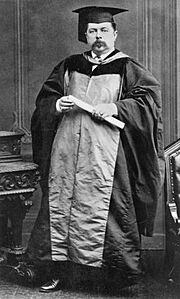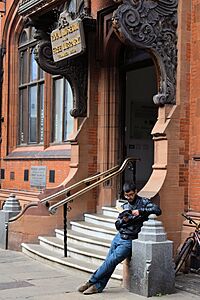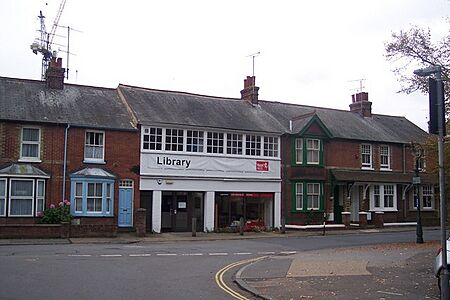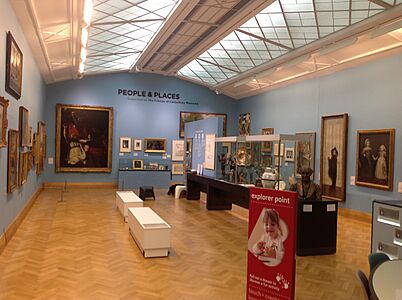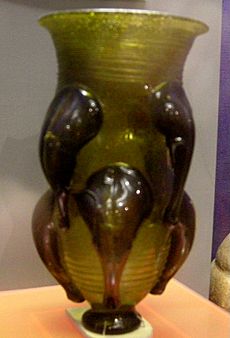Beaney House of Art and Knowledge facts for kids
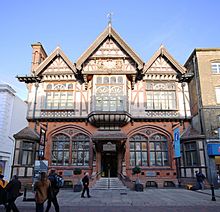
The building from the front
|
|
| Lua error in Module:Location_map at line 420: attempt to index field 'wikibase' (a nil value). | |
| Established | 1899 Closed for refurbishment 2009−2012 |
|---|---|
| Location | 18 High Street, Canterbury, Kent CT1 2RA, England |
| Type | Museum, art gallery, library, regimental museum |
| Public transit access | Rail: Canterbury West, Canterbury East Buses: National Express, Stagecoach |
The Beaney House of Art and Knowledge is a super cool place in Canterbury, Kent, England. It's a museum, an art gallery, and a library all in one! This amazing building is really old and special, known as a Grade II listed building.
Before 2009, it was called the Beaney Institute or the Royal Museum and Art Gallery. After some big updates, it reopened in September 2012 with its new name. The city council of Canterbury looks after the building and its collections. The county council manages the library. They all work together to make it a great place for everyone.
Contents
The Beaney's Story
How the Beaney Was Built
The Beaney Institute building looks like it's from the Tudor times, but it was actually designed in 1897. An architect named A.H. Campbell created the plans. It opened on September 11, 1899, and cost about £15,000 to build.
This all happened because a doctor named James George Beaney left £10,000 to Canterbury. He wanted an institute for working men. The city council added £5,000 more. This allowed the new building to also house the city's existing museum and library. That's why it was called "Royal" for a while!
The original museum and library started way back in 1825. It was first on Guildhall Street. Dr. Beaney was a very interesting person. He wanted his own pictures to be hung in the main hall of the new institute.
Many people helped with the building's inside. Joshua Cox gave £1,050. The Slater family helped build a new art gallery wing in 1934. The library and reading rooms were on the ground floor. The museum and art gallery were upstairs. The basement held natural history items and storage.
Some of the fancy mahogany display cases came from the British Museum. The Victoria and Albert Museum and Royal Doulton even lent items for the opening displays.
Life at the Beaney: 1900s to 2009
For many years, the Beaney was a busy place. From 1899 to 1913, Francis Bennett-Goldney was the main curator. The library grew a lot, from 12,000 books to two million by 2008! It had old texts from the 1600s and 1700s, maps, and local guides.
The building even inspired a movie! In the 1944 film A Canterbury Tale, the Beaney Institute was the idea behind the "Colpeper Institute." In 1957, they celebrated the 100th anniversary of writer Joseph Conrad with an exhibition.
The gallery also hosted cool art shows. From 2006 to 2007, there was an exhibition of Giles cartoons. For a long time, artists would draw on the pavement outside the building. It was a special tradition.
Making the Beaney Even Better
From 2009 to 2012, the Beaney closed for a big makeover. The goal was to make that part of the city a lively cultural hub. The Heritage Lottery Fund gave £6.5 million for the project. This money helped add more space, new facilities, and better displays. They also added a glass lift and educational rooms, making it easier for everyone to visit.
The updates meant they could show off collections that were hidden before. They also made the art gallery bigger and added more rooms for special exhibitions.
The library got a huge upgrade too. There's now more space for books, a special children's library, and a local studies center. There's even a dedicated area for teenagers! Local people, including teachers, helped plan these new spaces.
The total cost for the project was £11.5 million. Many groups helped with the funding. The architects who worked on the project also helped restore Windsor Castle after a fire! The inside designers created a fun theme called "explorer points."
Before closing, the museum had a "Hungry for Heritage" exhibition. Young people created art about the exhibits they would miss. These pictures were shown in Canterbury cafes while the Beaney was closed. The building officially closed on February 28, 2009.
Moving everything out was a huge job! They even had trouble moving Sidney Cooper's giant painting, Charlie the Bull, from the stairwell. While the Beaney was closed, the library's lending service moved to a temporary spot at Ede's Garage. They still had books, computers, DVDs, and story times for kids.
The building finally reopened in 2012, ready for everyone to enjoy its new look and amazing collections.
Amazing Collections at the Beaney
Art and Paintings

The Beaney gallery has a fantastic collection of art, especially by local artists. You can see works by Thomas Sidney Cooper and his family members. There are also older European paintings from the 1500s onwards.
A collection of English and Dutch art was given by Gerard Frederick de Zoete in 1906. The museum once had a Van Dyck painting of King James I's daughter and a Burne-Jones painting called Wheel of Fortune.
You can also find many engravings and prints of old Canterbury. There are even portraits, including one of Geoffrey Chaucer, who wrote The Canterbury Tales. One of the most important paintings bought for the museum was Sir Basil Dixwell by Van Dyck in 2004. During the refurbishment, these artworks were kept safe or shown at the Museum of Canterbury.
Original Treasures
The Beaney's original collections included beautiful English and European ceramics, plus oriental porcelain. There was also Anglo-Saxon grave jewelry found in Kent. You could see mounted animals, like birds, given by S. R. Lushington and the Hammond family.
A huge, 18th-century chandelier in the basement came from Canterbury Cathedral. The museum also had collections about geology and natural history. It once had three Māori tattooed heads, which were returned to New Zealand in the 1990s.
There were two ancient runestones from Sandwich, dating back to the 4th or 5th century. One might have been a headstone. The museum also had Ancient Greek bas relief tablets.
Another interesting item was St Augustine's Chair. People thought St Augustine sat in it long ago. It was given to the museum in 1899. While it's still part of the collection, it's now thought to be from the 1700s.
One of the museum's most special items was the Burghmote Horn. It was said to have called the city leaders to meetings from the time of King Henry III until 1835! You could also see pilgrims' tokens, which were souvenirs from the shrine of Thomas Becket. In 1975, the museum received the ancient helmet from St Alphege Church.
Over time, some of the prehistoric, Roman, and Anglo-Saxon items found in Kent were shared with other local museums. For example, a beautiful Anglo-Saxon glass beaker is now at Herne Bay Museum. Much of the Romano-British pottery and glass found in Canterbury is now at the Roman Museum. The remaining collections are stored at the Museum of Canterbury, with some items on display.
The Buffs Regiment History
The Beaney House also has a special room dedicated to the history of the Buffs (Royal East Kent Regiment). This regiment was a group of soldiers from Kent. Their archives moved to the Beaney in 1978.
The room tells the story of the regiment from the 1500s until 1961. That's when the regiment joined with another one. The collection includes pictures, trophies, uniforms, weapons, and medals. You can learn about their campaigns in places like North Africa, Burma, and during World War I and World War II.
The ownership of the Buffs collection was transferred to the National Army Museum in London in 2000. Some items are displayed there, and some are back in the new displays at the Beaney itself.


